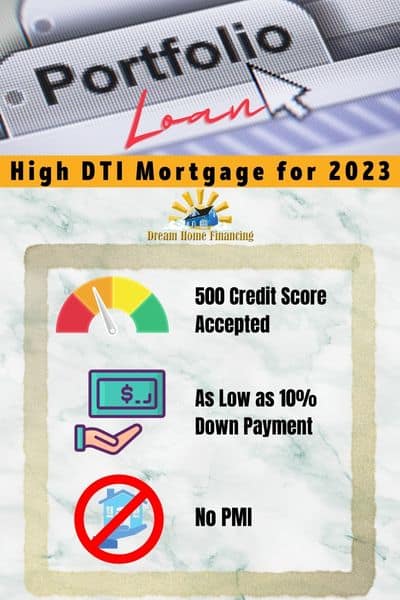High DTI Mortgage Lenders

If you are buying a home or looking to refinance, the first thing you need to determine is whether you will be able to qualify based upon your current income level. For a conventional loan, you must make enough so your back-end DTI ratio does not exceed 43%.
I will take you through the basic income requirements, so you know how much is needed to qualify for a mortgage. I will explain which programs and options exist if you need a lender who will allow for higher DTI ratio. Then, I will review the optimal payment and mortgage scenario for wealth building. First an education on how it is all calculated.
Click to get Pre-Approved with a High DTI
What is the DTI – Debt to Income Ratio?
The debt to income ratio or DTI is the calculation that lenders use to determine how much mortgage you can afford based upon your current income level. Lenders actually have two DTI calculations… the front-end DTI and back end DTI. The back-end DTI is the one that matters most when qualifying for a mortgage.
- Front End DTI Ratio– The front-end DTI ratio calculation is simply your proposed monthly mortgage payment (PITI – principle, interest, taxes and insurance) divided into your gross monthly income. If your proposed monthly mortgage payment is $2000 per month and your monthly gross income is $6000 per month, then your front-end DTI is 33% ($2000 divided into $6000).
- Back End DTI Ratio – The back-end DTI ratio calculation is all of your monthly obligations (including your proposed mortgage payment) divided into your gross monthly income. You will add your proposed monthly payments, plus any minimum monthly payments that show up on your credit report. This includes car payments, student loans, credit card minimum payments, and anything else that appears as a monthly obligation.
All of these monthly payments combined and then divided into your gross monthly income will be your back-end DTI. For conventional loans, the preferred maximum back end DTI is 43%. That being said, you should target 36%-38% as a more comfortable back end DTI ratio.
Click to See if You Qualify for a High DTI Mortgage
How much do I need to make to Qualify for a Mortgage?
Now that you know how to calculate your back-end DTI, you are on your way to knowing how much you need to make to qualify for a mortgage. What you really need to determine is how much mortgage you can afford. That is one of the first things to consider before buying a home.
One of the key factors that is often overlooked is the taxes on the home you are shopping for. You will be able to afford a more expensive home if the taxes are low. High property taxes will hurt your chances to qualify.
I recommend that you use a simple mortgage calculator and plug in an interest rate that is just slightly higher than what you may be seeing from lenders online.
High DTI Mortgage Lenders
There are high DTI mortgage lenders who will allow for a maximum DTI of 50% to 55% and with a down payment requirement as little as 10%
If you are truly trying to afford more home than what traditional lenders will allow, there are lenders who have special programs with a maximum back end DTI of 50%-55%. Lenders who offer high DTI mortgages are portfolio lenders who keep the loans in their own portfolios or sell them to private investors.
These niche programs have some or all of the following characteristics:
- As little as 10% down with good credit
- Credit scores into the 500’s permitted
- Available as a bank statement loan for self-employed individuals
- Typically, there no PMI needed even with less than 20% down
- Interest rates will likely be slightly higher than a conventional loan
High DTI mortgage lenders often change their guidelines and requirements. As a consumer, it is nearly impossible to know which lender is best for your loan scenario. We are connected to the high DTI mortgage lenders nationally so your first step to see if you qualify is to contact us for a free consultation.
High DTI Mortgage Options
There are a few high DTI mortgage options that you should consider. With these, you will overcome the issue you may have with conventional mortgages or traditional lenders who are telling you that your DTI is too high.
FHA Loans with High DTI
An FHA loan is the first option that you should consider. The debt to income ratio requirements will allow for a DTI up to 56.9%. The key here is to find a lender who is willing to allow for a DTI that high. There are lenders in our network who can help with this.
No Ratio Mortgages for High DTI
Another option when your DTI is high is a no ratio mortgage. With this mortgage, you do need the two year work history but the debt to income ratios will not be calculated or factored. You can expect the down payment and interest rates to be higher for this program. There are few lenders who offer this program but they are available.
HELOC with High DTI
If you are looking to cash out equity in your home and your DTI is too high, your local bank may not have the answer for you. Most of the HELOC loans are offered by local banks but unfortunately they do not allow for a high DTI.
Conversely, the niche lenders who offer alternative programs usually do not have HELOCs as part of their product offering. What you can find is a cash out refinance with a high DTI in lieu of a HELOC. This option involves refinancing your first mortgage for a higher amount so you can cash out the equity that you need. There are high DTI lenders who offer this option today.
Maximum Debt to Income Ratio for a Mortgage
If you are considering a mortgage with fully documented income requirements, the maximum debt to income ratio will be 56.9%. This mortgage program will be an FHA loan. Conventional loans unfortunately will cap the max DTI in the mid 40’s based upon the conventional income and DTI requirements.
Lenders are permitted to allow for a DTI of 56.9% with compensating factors such as a larger down payment or high credit scores.
There are other options such as a stated income loan where a high DTI will not have a negative impact on your mortgage approval.
Optimal DTI for Wealth Building
Would you like to be in debt the rest of your life or live comfortably years from now? We all want the best and we want it now and often we are not willing to sacrifice today for better days tomorrow.
The best thing you can do is buy a home with a 15 year fixed mortgage and with your total mortgage payment no more than 25% of your gross monthly income. If you are doing the math on that, you may think you cannot buy the home you want if you follow this calculation.
The idea behind this is to get the 15 year mortgage using a comfortable portion of your income. Then, as your income increases over the next few years, you add even more to your monthly payments. You would have the ability to pay off your mortgage in 10-12 years. Just another great tips for financing your home.
Related Questions
What is a good debt to income ratio?
Lenders look closely at your debt to income ratio when evaluating your mortgage application. A debt to income ratio less than 38% is optimal and will help you to qualify for a mortgage.
Are there high DTI Mortgage Lenders for FHA Loans?
There are some FHA lenders who will allow for a higher DTI and sometimes up to 50%. You should only consider this if you are confident that your income will increase in the near term.
How can I lower my DTI on my mortgage?
There are a few ways to lower your DTI on your mortgage. You can do the following:
- Increase your income
- Lower your interest rate
- Reduce other monthly debts which add to your DTI
- Find a home with lower taxes
Related Articles
Mortgage Loan Types – From Jeff Nelson
How to Find the Lowest Mortgage Rate
Top 25 Questions to Ask a Lender
Discussion Topics

